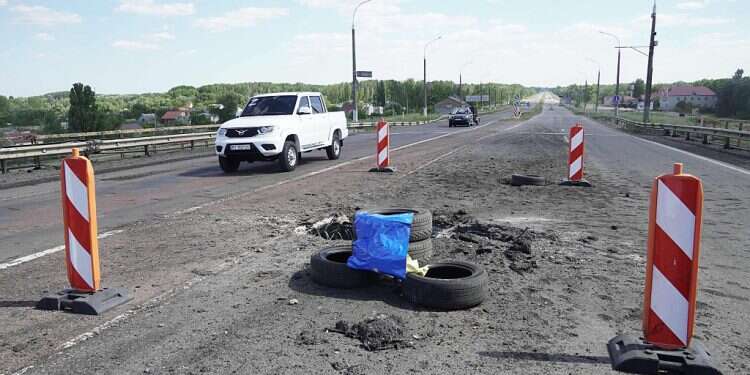For weeks, Ukraine's Kherson region, occupied by Russia, lives through anticipation of what is hanging by a string — a large Ukrainian counter-offensive.
The Battle of Donbas in Ukraine's east is not over yet, but Kyiv is already setting conditions to retake the city of Kherson, the only regional capital Russia has managed to seize in its all-out war since February. Ukraine's military has spent weeks deploying advanced Western weaponry against Russian munitions and fuel depots, bridges and air defense radars, in a bid to possibly win better chances in the upcoming battle. But Russia, in its turn, despite the threatening situation, is not ready to simply give up on its biggest gain in the war. In tense anticipation, it is rapidly reinforcing its groupings on the Dnipro River and preparing to counter the hard Ukrainian drive south.
Follow Israel Hayom on Facebook, Twitter, and Instagram
The battle of Ukraine's south is likely to open a new, third phase of the war. It's been nearly a month since Russia stopped all major offensive operations in the Donbas after it had finally captured the twin city of Severodonetsk and Lysychansk following nearly three months of fighting. Russia declared this "an operational pause" to regroup and continue the fight. According to analysts with the Institute for the Study of War, even a month after, the Russian military is still too depleted to wage any serious operations in the Donbas, except for against just two mid-sized regional cities of Bakhmut and Siversk.
Indeed, even though Russia continued to make efforts, it managed to make just very limited tactical gains, such as the capture of the defunct Vuhlehirska power plant by the Wagner Group mercenaries on July 26, also after nearly two months of fighting in the area. The war's focus is gradually switching from the east to the south, the Kherson region. Due to local terrain, the Ukrainian command sees opportunities.
Kherson, the regional capital of some 300,000, stands on the Dnipro River's west bank. Ukraine lost the city in the shock and awe of the earliest days of war, with little resistance. In that steppe riverside, there are very few ways to cross the Dnipro back and forth. Kherson has just two bridges, an automobile one and a railroad one, both called Antonisky. And there is another crossing via the Khakhovska power plant some 60 kilometers northeast.
And this is it – the nearest bridge across the Dnipro is in Zaporizhia over 170 kilometers farther, which is under firm Ukrainian control. In other words, Russia had just three roads to run supplies for its armed forces near Kherson across the river, which is at least 600 meters wide in those parts. Ukraine, meanwhile, is very open regarding its plans for Kherson. If those Russian supply lines are destroyed, Ukraine's military would get a chance to advance, isolate the Russians in Kherson, block the city — and keep it under siege until the garrison, cut off supplies and munitions, finally surrenders.
Standing back against the great river, Russians would find it impossible to send supplies and reinforcements to Kherson. And any pontoon crossings would be very vulnerable to Ukrainian fire and very easy to notice. Kherson, isolated and problematic in terms of supplies, is Russia's weakest and very dangerous spot in Ukraine. And what was just speculation among defense experts and Ukrainian media is now becoming the reality.
Over the last month, since it acquired the US-provided HIMARS rocket systems, Ukraine has been running a full-fledged campaign to derail Russian logistics and supplies in the south and the east. According to Ukraine's Defense Ministry, over 50 Russian munitions and fuel supplies have been destroyed. And the strike campaign continues. In Kherson and regional cities, every night is the night when social media see the influx of videos of gigantic explosions at Russian dumps close to railroad stations. Overnight into July 27, the Antonivsky automobile bridge, following a series of HIMARS strikes, was rendered unusable and closed to all traffic. Russia has already lost the main supply route to Kerhson. According to Russia's occupation administration, the railroad bridge standing not far away from its automobile twin has also been damaged.
As for the Kakhovka power plant dum, the last intact bridge across the Dnipro, it cannot be destroyed due to the deadly damage to the area if the levee breaks. But the Ukrainian military has repeatedly delivered strikes upon Russian military targets close to it, demonstrating its ability to keep the crossing under firm fire control.
The tension is growing fast – on both sides of the war. For Ukraine, retaking Kheron would be a groundbreaking blow upon Russian morale, the biggest success since the victory with the Battle of Kyiv in late March. But Russia is also not losing time, seeing this very potential danger. Amid its protracted general offensive in Donbas, which continues since mid-April, it just can't afford such a strong political and military setback.
It's preparing to repel a Ukrainian offensive and then counter-attack. It has already established an in-depth defense in the region, with concrete pillboxes protecting machine gun nests. Air defenses are still very strong. It's already installing pontoon crossings in the region, knowing that Ukraine will render all bridges unusable. According to Ukrainian intelligence, over the last week, Russia has seriously amplified its grouping on the Dnipro west bank, deploying most of its elite airborne units to uphold Kherson.
The stakes are now extremely high.
Illia Ponomarenko is a defense and security reporter with The Kyiv Independent in Ukraine.
Subscribe to Israel Hayom's daily newsletter and never miss our top stories!




